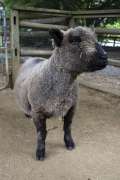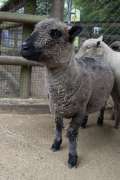Southdown Baby Doll Sheep
Southdown Baby Doll Sheep
Their name refers to their cute, teddy bear-like appearance and the fact that the breed was developed in the South Down region of Sussex in England. This breed of sheep has a luxuriant coat that makes them very popular for their wool, which can be woven into similarly fine garments. Sheep were among one of the very first domesticated animals, and they have been part of human life as companions and sources of wool and food for millennia. Many thousands of years of selective breeding have produced a large of number of breeds specialized for different purposes and climates.
Ovis aries
Herbivore
Europe [VIEW MAP]
Urban Areas
The individual barnyard animals at Outback Station are rotated in and out of the petting zoo at various times of the day. Guests may enjoy time with the animals anytime except during the coldest or rainiest conditions, but it will always be a surprise to find which specific breeds and individual animals are there to greet them.
Photos and Videos
This breed originated in the South Downs of Sussex County, England. In 1780, John Ellman set out to standardize the Southdown breed in England. The breed’s popularity grew until the early 1900s, when World War I brought a sharp decline in their numbers. Demand for larger cuts of meat almost forced the breed to extinction. The breed reached the U.S. in 1803, and their popularity trend in the States was similar to that in England. In 1986, Robert Mock began to search for the original bloodlines and rebuilt the babydoll breed that we know today. These sheep have a teddy-bear appearance, with wooly faces that always appear to be smiling. Babydoll wool is one of the finest wools of all the British breeds. It is springy, soft and generally short, only about two inches in length.
Coat colors in these sheep tend to be white/off-white and black. Babydoll Southdown wool is dense yet fine in texture, covering the sheep’s entire body with the exception of the area around the eyes and the bridge of the nose.
Mature babydoll Southdown sheep generally stand 18 to 24 inches tall at the withers when shorn. Their weight averages 60 to 125 pounds.
These sheep live about 10 years. The ewe’s cycle lasts 13 to 19 days. Estrus lasts 18 to 48 hours. Gestation lasts 138 to 149 days and usually results in twins, but single kids or even triplets also occur.
Rams smell to tell if a ewe is in estrus by the behavior known as “flehmen.” In this behavior, they extend their necks and heads into the air and curl up their upper lips.
The individual barnyard animals at Outback Station are rotated in and out of the petting zoo at various times of the day. Guests may enjoy time with the animals anytime except during the coldest or rainiest conditions, but it will always be a surprise to find which specific breeds and individual animals are there to greet them.
This breed was developed in England. They are now maintained as domestic animals worldwide.
At the Zoo, we offer the goats a varied diet of Bermuda hay, browse (clippings from non-toxic plants across the Zoo), some grain and produce.




